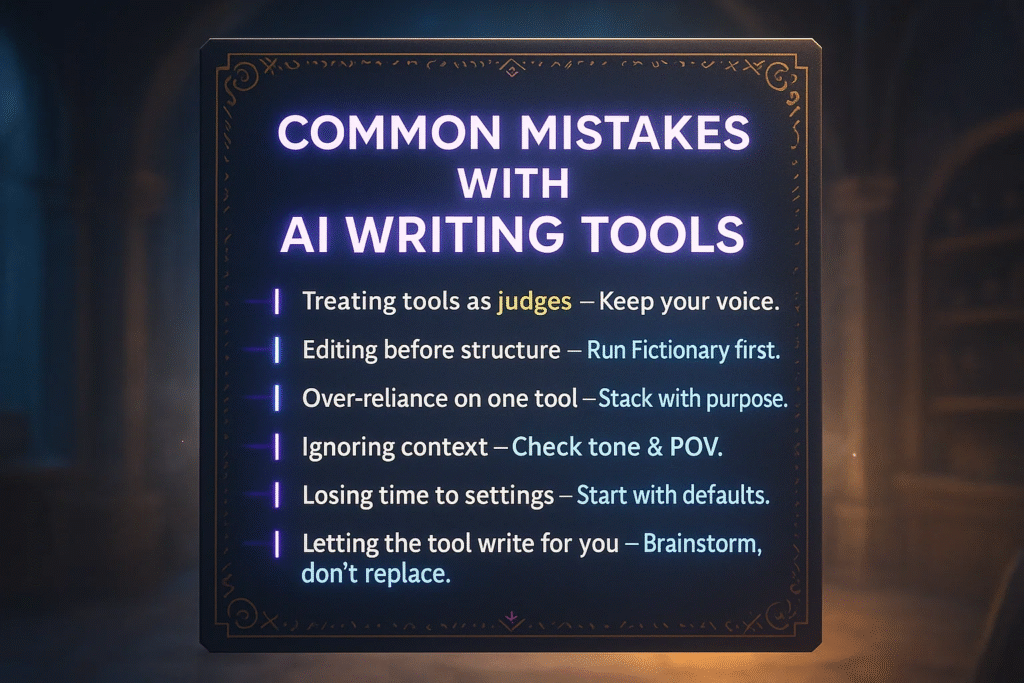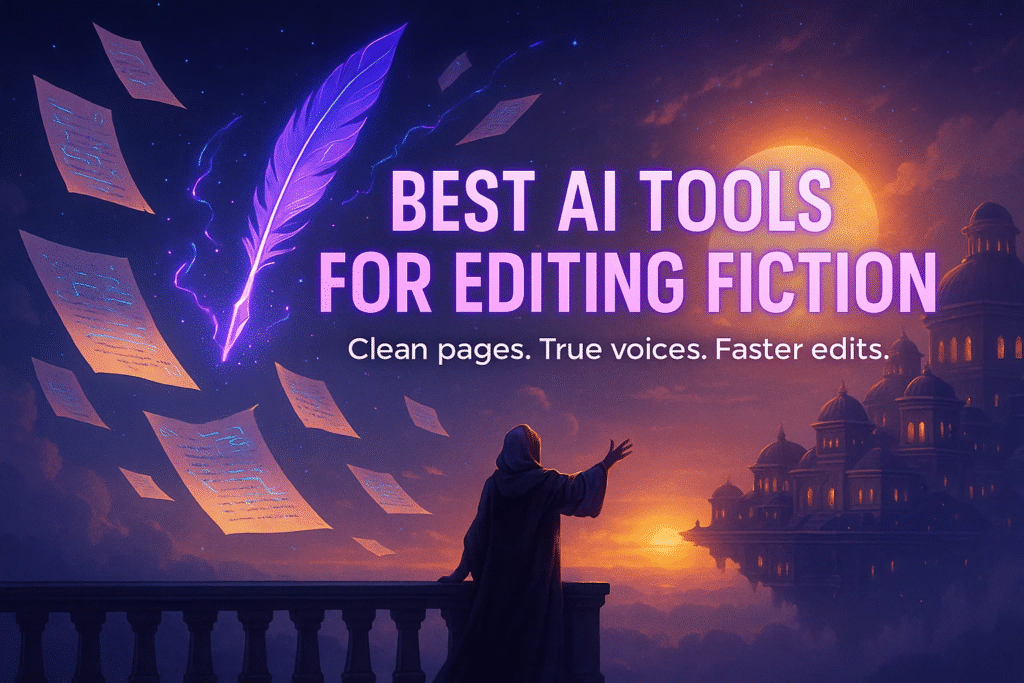The 5 Best AI Tools for Editing Fiction (Compared)
What if the next 10 minutes could save your novel?
Your pages feel close. Yet something drags. You want clean, strong prose. You also want to keep your voice. The best AI tools promise help. Some sharpen your lines. Some flatten them. Which ones earn a place in your process?
Here’s the plan. We start with the pain: heavy scenes, flat dialogue, foggy beats. Then we test five real fixes. You’ll see what each tool does well, where it slips, and how to fit it into your writing process.
👉There’s a twist at the end. After the line edit, your story still has to breathe. That’s where Summon Worlds steps in. It helps you pressure-test voice, pace, and lore. It turns clean text into living scenes.
Curious which tools make the cut, and which ones waste your time? Keep reading.
Table of Contents

Top 5 Best AI Tools for Editing Fiction
1) ProWritingAid: style depth for storytellers
✅Best for: line edits plus fiction-aware checks
ProWritingAid gives deep style feedback. It flags sticky sentences, echoes, weak verbs, and tense slips. For novelists, its reports on pacing, dialogue tags, and repeats are very handy. It also works inside Google Docs through an extension, so you can edit as you draft.
❓Why fiction writers like it
- Broad set of reports that suit long scenes.
- Good at finding bloat and rhythm issues.
- Strong fit for the day-to-day writing process.
❗️Watch-outs
- Lots of reports can feel heavy at first.
- It can nudge toward safe phrasing. Keep your edge.
💰Free trial / plans
- There’s a free tier. Premium adds full reports. Many writers test it with a short free trial before they commit.
✨Bottom line: A steady AI writing assistant for line-level craft. Great if you want targeted style fixes but still want to sound like you.
2) AutoCrit: genre-aware, fiction-first
✅Best for: pace, repetition, and genre comparison
AutoCrit was built for fiction writers. It checks pacing, filler words, and dialogue balance, and lets you compare your prose to popular novels in your genre. The feedback is direct and focused on what readers feel on the page.
❓Why fiction authors pick it
- Fiction-specific checks and strong pacing tools.
- Useful “compare to bestsellers” view for gut checks.
❗️Watch-outs
- Limited outside strict line/style areas.
- Interface feels older than some rivals.
💰Free trial / plans
- Has a free plan. Paid plans unlock full analysis.
✨Bottom line: If you write in clear genre lanes, AutoCrit gives no-nonsense signals that help you tighten scenes fast.
3) Fictionary: structure, arc, and scene health
✅Best for: developmental checks before the line edit
Fictionary looks at story shape. It maps your story arc, tracks point of view, scene goals, and turning points. You see if hooks land, if tension rises, and if your scenes pull their weight. It is less about commas and more about “does this chapter work?”
❓Why storytellers love it
- Visuals for plot, POV, and character momentum.
- A checklist of 30+ story elements to scan each scene.
- Ideal before copyedits so you do not polish the wrong draft.
❗️Watch-outs
- Not a grammar tool. Pair it with a line editor.
- You’ll need to import your manuscript and tag scenes.
💰Free trial / plans
- Offers a short free trial so you can test it with one act or a few chapters.
✨Bottom line: When your structure feels off, Fictionary shows where to cut, expand, or move beats. It saves months of guesswork.
4) Grammarly: fast polish in Google Docs
✅Best for: everyday clarity and tone
Grammarly is a general purpose AI editor with strong grammar, clarity, and tone help. It runs in your browser and inside Google Docs with an extension. It also gives tone suggestions, which help keep character voice steady across chapters or platform posts.
❓Why it’s useful
- Quick fixes for tense, agreement, and phrasing.
- Helpful tone nudges when switching POVs.
- Good for query letters and social media blurbs too.
❗️Watch-outs
- Less granular about fiction-specific issues.
- Can smooth your voice if you accept every change.
💰Free trial / plans
- Has a free plan that covers basics. Paid adds advanced clarity, fluency, and more.
✨Bottom line: If you live in Google Docs, Grammarly is an easy win. Use it for clean copy and tone checks, then layer a fiction-focused tool for deeper craft.
5) Hemingway Editor: trim, tighten, punch
✅Best for: cutting clutter and boosting readability
Hemingway highlights adverbs, passive voice, and hard-to-read sentences. It gives a readability grade and shows where to trim. Many novelists run chapters through it to make heavy passages lighter. There’s a free web version and a low-cost desktop app.
❓Why it helps
- Instant clarity.
- Great for action scenes and dialogue trims.
- Simple, user friendly view with no fuss.
❗️Watch-outs
- It is mechanical. You still decide what to keep.
- Not built for plot or character work.
💰Free trial / plans
- Web tool is free. Desktop is a small one-time cost.
✨Bottom line: When your page feels muddy, Hemingway is a strong last pass. Use it to cut noise and sharpen flow.
Read our article about Best Generator Tools For AI Worldbuilding
Common Mistakes With AI Writing Tools (And How to Fix Them)

Mistake 1: Treating tools as judges
🛠️Fix: Keep your voice. Accept only changes that serve the scene.
Mistake 2: Editing before structure
🛠️Fix: If your plot sags, run a structure pass in Fictionary first. Then polish lines.
Mistake 3: Over-reliance on one tool
🛠️Fix: Stack tools. For example, ProWritingAid for style, then Hemingway for clarity.
Mistake 4: Ignoring context
🛠️Fix: For tone and POV, let Grammarly flag shifts. Then read the chapter aloud.
Mistake 5: Losing time to settings
🛠️Fix: Start with defaults. Tweak rules later. Reduce your learning curve.
Mistake 6: Relying on the tool to write for you
🛠️Fix: Some tools can help with generating text or generating content. Use that to brainstorm, not to replace your draft.
Read our article about Character AI Tool Alternatives
Summon Worlds: Easy Tips to Improve Your Edit
Your draft is clean. Now make the story sing.
- Test dialogue with Character Chat: Paste a scene and chat in-character. Hear how your hero talks. Adjust beats that feel off. This is great when you want to overcome writers block and keep momentum.
- Lock tone with Memory: Use character instructions so replies keep traits, speech patterns, and mood. This helps fiction authors keep voice steady across chapters.
- Scene checks with world lore: Summon Worlds remembers places, items, and history. Ask, “What did I call this tavern?” Keep continuity tight.
- Try voices: Use voice options to hear a line. If your scene still feels flat, explore how visual character design can inspire tone and rhythm in your dialogue.
- Balance show vs. tell: Ask for examples that “show” the beat in your scene. Keep your words, but study the rhythm.
- Guardrails: Summon Worlds works with different AI models (yes, the big large language models under the hood). Use memory controls to keep your facts straight and avoid drift.
- Cost view: See the cost per message so you can plan sprints around key scenes.
Summon Worlds is not a grammar checker. It is the creative layer after the edit. Treat it as your AI writing tools companion, not a replacement for your editor.
🧭 Ready to Polish Your Story? Use the Best AI Tools and Summon Worlds

Great stories are simple at the core: clear scenes, true voices, clean pages. Pick a tight stack and move. Map the bones with Fictionary. Tune style and pace with ProWritingAid or AutoCrit. Sweep for clarity with Grammarly and Hemingway. Fast. Focused. No bloat. Your learning curve stays light. Your voice stays loud.
Now turn polish into power. Open Summon Worlds. Chat with your cast. Check lore in seconds. Hear rhythm. Fix slips before they grow. Feel the chapter click into place.
Ready to act? Get Summon Worlds now.
Disclaimer: Summon Worlds and the content on summonworlds.com are not affiliated with, endorsed by, or sponsored by Wizards of the Coast LLC. Dungeons & Dragons, D&D, and related terms are registered trademarks of Wizards of the Coast. Any references to D&D game mechanics, settings, or terminology are made for educational, commentary, and fan content purposes only. This blog does not reproduce or distribute official D&D content. All original ideas, characters, and creative content in this post are the intellectual property of OpenForge LLC, the parent company of Summon Worlds.



![{"type":"elementor","siteurl":"https://www.summonworlds.com/wp-json/","elements":[{"id":"f93d843","elType":"widget","isInner":false,"isLocked":false,"settings":{"editor":"Try Summon Worlds for free. ","ha_advanced_tooltip_content":"I am a tooltip","ha_cmc_text":"Happy Addons","align":"center","typography_typography":"custom","typography_font_size":{"unit":"px","size":23,"sizes":[]},"link_color":"#D94FF9","drop_cap":"","text_columns":"","text_columns_tablet":"","text_columns_mobile":"","column_gap":{"unit":"px","size":"","sizes":[]},"column_gap_tablet":{"unit":"px","size":"","sizes":[]},"column_gap_mobile":{"unit":"px","size":"","sizes":[]},"align_tablet":"","align_mobile":"","typography_font_family":"","typography_font_size_tablet":{"unit":"px","size":"","sizes":[]},"typography_font_size_mobile":{"unit":"px","size":"","sizes":[]},"typography_font_weight":"","typography_text_transform":"","typography_font_style":"","typography_text_decoration":"","typography_line_height":{"unit":"px","size":"","sizes":[]},"typography_line_height_tablet":{"unit":"em","size":"","sizes":[]},"typography_line_height_mobile":{"unit":"em","size":"","sizes":[]},"typography_letter_spacing":{"unit":"px","size":"","sizes":[]},"typography_letter_spacing_tablet":{"unit":"px","size":"","sizes":[]},"typography_letter_spacing_mobile":{"unit":"px","size":"","sizes":[]},"typography_word_spacing":{"unit":"px","size":"","sizes":[]},"typography_word_spacing_tablet":{"unit":"em","size":"","sizes":[]},"typography_word_spacing_mobile":{"unit":"em","size":"","sizes":[]},"text_shadow_text_shadow_type":"","text_shadow_text_shadow":{"horizontal":0,"vertical":0,"blur":10,"color":"rgba(0,0,0,0.3)"},"paragraph_spacing":{"unit":"px","size":"","sizes":[]},"paragraph_spacing_tablet":{"unit":"px","size":"","sizes":[]},"paragraph_spacing_mobile":{"unit":"px","size":"","sizes":[]},"text_color":"","link_hover_color":"","link_hover_color_transition_duration":{"unit":"s","size":"","sizes":[]},"drop_cap_view":"default","drop_cap_primary_color":"","drop_cap_secondary_color":"","drop_cap_shadow_text_shadow_type":"","drop_cap_shadow_text_shadow":{"horizontal":0,"vertical":0,"blur":10,"color":"rgba(0,0,0,0.3)"},"drop_cap_size":{"unit":"px","size":5,"sizes":[]},"drop_cap_space":{"unit":"px","size":10,"sizes":[]},"drop_cap_border_radius":{"unit":"%","size":"","sizes":[]},"drop_cap_border_width":{"unit":"px","top":"","right":"","bottom":"","left":"","isLinked":true},"drop_cap_typography_typography":"","drop_cap_typography_font_family":"","drop_cap_typography_font_size":{"unit":"px","size":"","sizes":[]},"drop_cap_typography_font_size_tablet":{"unit":"px","size":"","sizes":[]},"drop_cap_typography_font_size_mobile":{"unit":"px","size":"","sizes":[]},"drop_cap_typography_font_weight":"","drop_cap_typography_text_transform":"","drop_cap_typography_font_style":"","drop_cap_typography_text_decoration":"","drop_cap_typography_line_height":{"unit":"px","size":"","sizes":[]},"drop_cap_typography_line_height_tablet":{"unit":"em","size":"","sizes":[]},"drop_cap_typography_line_height_mobile":{"unit":"em","size":"","sizes":[]},"drop_cap_typography_word_spacing":{"unit":"px","size":"","sizes":[]},"drop_cap_typography_word_spacing_tablet":{"unit":"em","size":"","sizes":[]},"drop_cap_typography_word_spacing_mobile":{"unit":"em","size":"","sizes":[]},"_title":"","_margin":{"unit":"px","top":"","right":"","bottom":"","left":"","isLinked":true},"_margin_tablet":{"unit":"px","top":"","right":"","bottom":"","left":"","isLinked":true},"_margin_mobile":{"unit":"px","top":"","right":"","bottom":"","left":"","isLinked":true},"_padding":{"unit":"px","top":"","right":"","bottom":"","left":"","isLinked":true},"_padding_tablet":{"unit":"px","top":"","right":"","bottom":"","left":"","isLinked":true},"_padding_mobile":{"unit":"px","top":"","right":"","bottom":"","left":"","isLinked":true},"_element_width":"","_element_width_tablet":"","_element_width_mobile":"","_element_custom_width":{"unit":"%","size":"","sizes":[]},"_element_custom_width_tablet":{"unit":"px","size":"","sizes":[]},"_element_custom_width_mobile":{"unit":"px","size":"","sizes":[]},"_grid_column":"","_grid_column_tablet":"","_grid_column_mobile":"","_grid_column_custom":"","_grid_column_custom_tablet":"","_grid_column_custom_mobile":"","_grid_row":"","_grid_row_tablet":"","_grid_row_mobile":"","_grid_row_custom":"","_grid_row_custom_tablet":"","_grid_row_custom_mobile":"","_flex_align_self":"","_flex_align_self_tablet":"","_flex_align_self_mobile":"","_flex_order":"","_flex_order_tablet":"","_flex_order_mobile":"","_flex_order_custom":"","_flex_order_custom_tablet":"","_flex_order_custom_mobile":"","_flex_size":"","_flex_size_tablet":"","_flex_size_mobile":"","_flex_grow":1,"_flex_grow_tablet":"","_flex_grow_mobile":"","_flex_shrink":1,"_flex_shrink_tablet":"","_flex_shrink_mobile":"","_element_vertical_align":"","_element_vertical_align_tablet":"","_element_vertical_align_mobile":"","_position_description":"","_position":"","_offset_orientation_h":"start","_offset_x":{"unit":"px","size":0,"sizes":[]},"_offset_x_tablet":{"unit":"px","size":"","sizes":[]},"_offset_x_mobile":{"unit":"px","size":"","sizes":[]},"_offset_x_end":{"unit":"px","size":0,"sizes":[]},"_offset_x_end_tablet":{"unit":"px","size":"","sizes":[]},"_offset_x_end_mobile":{"unit":"px","size":"","sizes":[]},"_offset_orientation_v":"start","_offset_y":{"unit":"px","size":0,"sizes":[]},"_offset_y_tablet":{"unit":"px","size":"","sizes":[]},"_offset_y_mobile":{"unit":"px","size":"","sizes":[]},"_offset_y_end":{"unit":"px","size":0,"sizes":[]},"_offset_y_end_tablet":{"unit":"px","size":"","sizes":[]},"_offset_y_end_mobile":{"unit":"px","size":"","sizes":[]},"_z_index":"","_z_index_tablet":"","_z_index_mobile":"","_element_id":"","_css_classes":"","e_display_conditions":"","_element_cache":"","wgl_pointer_events":"","ha_floating_fx":"","ha_floating_fx_translate_toggle":"","ha_floating_fx_translate_x":{"unit":"px","size":"","sizes":{"from":0,"to":5}},"ha_floating_fx_translate_y":{"unit":"px","size":"","sizes":{"from":0,"to":5}},"ha_floating_fx_translate_duration":{"unit":"px","size":1000,"sizes":[]},"ha_floating_fx_translate_delay":{"unit":"px","size":"","sizes":[]},"ha_floating_fx_rotate_toggle":"","ha_floating_fx_rotate_x":{"unit":"px","size":"","sizes":{"from":0,"to":45}},"ha_floating_fx_rotate_y":{"unit":"px","size":"","sizes":{"from":0,"to":45}},"ha_floating_fx_rotate_z":{"unit":"px","size":"","sizes":{"from":0,"to":45}},"ha_floating_fx_rotate_duration":{"unit":"px","size":1000,"sizes":[]},"ha_floating_fx_rotate_delay":{"unit":"px","size":"","sizes":[]},"ha_floating_fx_scale_toggle":"","ha_floating_fx_scale_x":{"unit":"px","size":"","sizes":{"from":1,"to":1.2}},"ha_floating_fx_scale_y":{"unit":"px","size":"","sizes":{"from":1,"to":1.2}},"ha_floating_fx_scale_duration":{"unit":"px","size":1000,"sizes":[]},"ha_floating_fx_scale_delay":{"unit":"px","size":"","sizes":[]},"ha_element_link":{"url":"","is_external":"","nofollow":"","custom_attributes":""},"ha_transform_fx":"","ha_transform_fx_translate_toggle":"","ha_transform_fx_translate_x":{"unit":"px","size":"","sizes":[]},"ha_transform_fx_translate_x_tablet":{"unit":"px","size":"","sizes":[]},"ha_transform_fx_translate_x_mobile":{"unit":"px","size":"","sizes":[]},"ha_transform_fx_translate_y":{"unit":"px","size":"","sizes":[]},"ha_transform_fx_translate_y_tablet":{"unit":"px","size":"","sizes":[]},"ha_transform_fx_translate_y_mobile":{"unit":"px","size":"","sizes":[]},"ha_transform_fx_rotate_toggle":"","ha_transform_fx_rotate_mode":"loose","ha_transform_fx_rotate_x":{"unit":"px","size":"","sizes":[]},"ha_transform_fx_rotate_x_tablet":{"unit":"px","size":"","sizes":[]},"ha_transform_fx_rotate_x_mobile":{"unit":"px","size":"","sizes":[]},"ha_transform_fx_rotate_y":{"unit":"px","size":"","sizes":[]},"ha_transform_fx_rotate_y_tablet":{"unit":"px","size":"","sizes":[]},"ha_transform_fx_rotate_y_mobile":{"unit":"px","size":"","sizes":[]},"ha_transform_fx_rotate_z":{"unit":"px","size":"","sizes":[]},"ha_transform_fx_rotate_z_tablet":{"unit":"px","size":"","sizes":[]},"ha_transform_fx_rotate_z_mobile":{"unit":"px","size":"","sizes":[]},"ha_transform_fx_scale_toggle":"","ha_transform_fx_scale_mode":"loose","ha_transform_fx_scale_x":{"unit":"px","size":1,"sizes":[]},"ha_transform_fx_scale_x_tablet":{"unit":"px","size":"","sizes":[]},"ha_transform_fx_scale_x_mobile":{"unit":"px","size":"","sizes":[]},"ha_transform_fx_scale_y":{"unit":"px","size":1,"sizes":[]},"ha_transform_fx_scale_y_tablet":{"unit":"px","size":"","sizes":[]},"ha_transform_fx_scale_y_mobile":{"unit":"px","size":"","sizes":[]},"ha_transform_fx_skew_toggle":"","ha_transform_fx_skew_x":{"unit":"px","size":"","sizes":[]},"ha_transform_fx_skew_x_tablet":{"unit":"px","size":"","sizes":[]},"ha_transform_fx_skew_x_mobile":{"unit":"px","size":"","sizes":[]},"ha_transform_fx_skew_y":{"unit":"px","size":"","sizes":[]},"ha_transform_fx_skew_y_tablet":{"unit":"px","size":"","sizes":[]},"ha_transform_fx_skew_y_mobile":{"unit":"px","size":"","sizes":[]},"ha_transform_fx_translate_toggle_hover":"","ha_transform_fx_translate_x_hover":{"unit":"px","size":"","sizes":[]},"ha_transform_fx_translate_x_hover_tablet":{"unit":"px","size":"","sizes":[]},"ha_transform_fx_translate_x_hover_mobile":{"unit":"px","size":"","sizes":[]},"ha_transform_fx_translate_y_hover":{"unit":"px","size":"","sizes":[]},"ha_transform_fx_translate_y_hover_tablet":{"unit":"px","size":"","sizes":[]},"ha_transform_fx_translate_y_hover_mobile":{"unit":"px","size":"","sizes":[]},"ha_transform_fx_rotate_toggle_hover":"","ha_transform_fx_rotate_mode_hover":"loose","ha_transform_fx_rotate_x_hover":{"unit":"px","size":"","sizes":[]},"ha_transform_fx_rotate_x_hover_tablet":{"unit":"px","size":"","sizes":[]},"ha_transform_fx_rotate_x_hover_mobile":{"unit":"px","size":"","sizes":[]},"ha_transform_fx_rotate_y_hover":{"unit":"px","size":"","sizes":[]},"ha_transform_fx_rotate_y_hover_tablet":{"unit":"px","size":"","sizes":[]},"ha_transform_fx_rotate_y_hover_mobile":{"unit":"px","size":"","sizes":[]},"ha_transform_fx_rotate_z_hover":{"unit":"px","size":"","sizes":[]},"ha_transform_fx_rotate_z_hover_tablet":{"unit":"px","size":"","sizes":[]},"ha_transform_fx_rotate_z_hover_mobile":{"unit":"px","size":"","sizes":[]},"ha_transform_fx_scale_toggle_hover":"","ha_transform_fx_scale_mode_hover":"loose","ha_transform_fx_scale_x_hover":{"unit":"px","size":1,"sizes":[]},"ha_transform_fx_scale_x_hover_tablet":{"unit":"px","size":"","sizes":[]},"ha_transform_fx_scale_x_hover_mobile":{"unit":"px","size":"","sizes":[]},"ha_transform_fx_scale_y_hover":{"unit":"px","size":1,"sizes":[]},"ha_transform_fx_scale_y_hover_tablet":{"unit":"px","size":"","sizes":[]},"ha_transform_fx_scale_y_hover_mobile":{"unit":"px","size":"","sizes":[]},"ha_transform_fx_skew_toggle_hover":"","ha_transform_fx_skew_x_hover":{"unit":"px","size":"","sizes":[]},"ha_transform_fx_skew_x_hover_tablet":{"unit":"px","size":"","sizes":[]},"ha_transform_fx_skew_x_hover_mobile":{"unit":"px","size":"","sizes":[]},"ha_transform_fx_skew_y_hover":{"unit":"px","size":"","sizes":[]},"ha_transform_fx_skew_y_hover_tablet":{"unit":"px","size":"","sizes":[]},"ha_transform_fx_skew_y_hover_mobile":{"unit":"px","size":"","sizes":[]},"ha_transform_fx_transition_duration":{"unit":"px","size":"","sizes":[]},"ha_advanced_tooltip_enable":"","ha_advanced_tooltip_position":"top","ha_advanced_tooltip_position_tablet":"","ha_advanced_tooltip_position_mobile":"","ha_advanced_tooltip_animation":"","ha_advanced_tooltip_duration":1000,"ha_advanced_tooltip_arrow":"true","ha_advanced_tooltip_trigger":"hover","ha_advanced_tooltip_distance":{"unit":"px","size":"0","sizes":[]},"ha_advanced_tooltip_distance_tablet":{"unit":"px","size":"","sizes":[]},"ha_advanced_tooltip_distance_mobile":{"unit":"px","size":"","sizes":[]},"ha_advanced_tooltip_align":"center","ha_advanced_tooltip_align_tablet":"","ha_advanced_tooltip_align_mobile":"","ha_advanced_tooltip_width":{"unit":"px","size":"120","sizes":[]},"ha_advanced_tooltip_width_tablet":{"unit":"px","size":"","sizes":[]},"ha_advanced_tooltip_width_mobile":{"unit":"px","size":"","sizes":[]},"ha_advanced_tooltip_arrow_size":{"unit":"px","size":"5","sizes":[]},"ha_advanced_tooltip_arrow_size_tablet":{"unit":"px","size":"","sizes":[]},"ha_advanced_tooltip_arrow_size_mobile":{"unit":"px","size":"","sizes":[]},"ha_advanced_tooltip_typography_typography":"yes","ha_advanced_tooltip_typography_font_family":"Nunito","ha_advanced_tooltip_typography_font_size":{"unit":"px","size":"14","sizes":[]},"ha_advanced_tooltip_typography_font_size_tablet":{"unit":"px","size":"","sizes":[]},"ha_advanced_tooltip_typography_font_size_mobile":{"unit":"px","size":"","sizes":[]},"ha_advanced_tooltip_typography_font_weight":"500","ha_advanced_tooltip_typography_text_transform":"","ha_advanced_tooltip_typography_font_style":"","ha_advanced_tooltip_typography_text_decoration":"","ha_advanced_tooltip_typography_line_height":{"unit":"px","size":"","sizes":[]},"ha_advanced_tooltip_typography_line_height_tablet":{"unit":"em","size":"","sizes":[]},"ha_advanced_tooltip_typography_line_height_mobile":{"unit":"em","size":"","sizes":[]},"ha_advanced_tooltip_typography_letter_spacing":{"unit":"px","size":"","sizes":[]},"ha_advanced_tooltip_typography_letter_spacing_tablet":{"unit":"px","size":"","sizes":[]},"ha_advanced_tooltip_typography_letter_spacing_mobile":{"unit":"px","size":"","sizes":[]},"ha_advanced_tooltip_typography_word_spacing":{"unit":"px","size":"","sizes":[]},"ha_advanced_tooltip_typography_word_spacing_tablet":{"unit":"em","size":"","sizes":[]},"ha_advanced_tooltip_typography_word_spacing_mobile":{"unit":"em","size":"","sizes":[]},"ha_advanced_tooltip_title_section_bg_color_background":"","ha_advanced_tooltip_title_section_bg_color_gradient_notice":"","ha_advanced_tooltip_title_section_bg_color_color":"","ha_advanced_tooltip_title_section_bg_color_color_stop":{"unit":"%","size":0,"sizes":[]},"ha_advanced_tooltip_title_section_bg_color_color_stop_tablet":{"unit":"%"},"ha_advanced_tooltip_title_section_bg_color_color_stop_mobile":{"unit":"%"},"ha_advanced_tooltip_title_section_bg_color_color_b":"#f2295b","ha_advanced_tooltip_title_section_bg_color_color_b_stop":{"unit":"%","size":100,"sizes":[]},"ha_advanced_tooltip_title_section_bg_color_color_b_stop_tablet":{"unit":"%"},"ha_advanced_tooltip_title_section_bg_color_color_b_stop_mobile":{"unit":"%"},"ha_advanced_tooltip_title_section_bg_color_gradient_type":"linear","ha_advanced_tooltip_title_section_bg_color_gradient_angle":{"unit":"deg","size":180,"sizes":[]},"ha_advanced_tooltip_title_section_bg_color_gradient_angle_tablet":{"unit":"deg"},"ha_advanced_tooltip_title_section_bg_color_gradient_angle_mobile":{"unit":"deg"},"ha_advanced_tooltip_title_section_bg_color_gradient_position":"center center","ha_advanced_tooltip_title_section_bg_color_gradient_position_tablet":"","ha_advanced_tooltip_title_section_bg_color_gradient_position_mobile":"","ha_advanced_tooltip_title_section_bg_color_image":{"url":"","id":"","size":""},"ha_advanced_tooltip_title_section_bg_color_image_tablet":{"url":"","id":"","size":""},"ha_advanced_tooltip_title_section_bg_color_image_mobile":{"url":"","id":"","size":""},"ha_advanced_tooltip_title_section_bg_color_position":"","ha_advanced_tooltip_title_section_bg_color_position_tablet":"","ha_advanced_tooltip_title_section_bg_color_position_mobile":"","ha_advanced_tooltip_title_section_bg_color_xpos":{"unit":"px","size":0,"sizes":[]},"ha_advanced_tooltip_title_section_bg_color_xpos_tablet":{"unit":"px","size":0,"sizes":[]},"ha_advanced_tooltip_title_section_bg_color_xpos_mobile":{"unit":"px","size":0,"sizes":[]},"ha_advanced_tooltip_title_section_bg_color_ypos":{"unit":"px","size":0,"sizes":[]},"ha_advanced_tooltip_title_section_bg_color_ypos_tablet":{"unit":"px","size":0,"sizes":[]},"ha_advanced_tooltip_title_section_bg_color_ypos_mobile":{"unit":"px","size":0,"sizes":[]},"ha_advanced_tooltip_title_section_bg_color_attachment":"","ha_advanced_tooltip_title_section_bg_color_repeat":"","ha_advanced_tooltip_title_section_bg_color_repeat_tablet":"","ha_advanced_tooltip_title_section_bg_color_repeat_mobile":"","ha_advanced_tooltip_title_section_bg_color_size":"","ha_advanced_tooltip_title_section_bg_color_size_tablet":"","ha_advanced_tooltip_title_section_bg_color_size_mobile":"","ha_advanced_tooltip_title_section_bg_color_bg_width":{"unit":"%","size":100,"sizes":[]},"ha_advanced_tooltip_title_section_bg_color_bg_width_tablet":{"unit":"px","size":"","sizes":[]},"ha_advanced_tooltip_title_section_bg_color_bg_width_mobile":{"unit":"px","size":"","sizes":[]},"ha_advanced_tooltip_title_section_bg_color_video_link":"","ha_advanced_tooltip_title_section_bg_color_video_start":"","ha_advanced_tooltip_title_section_bg_color_video_end":"","ha_advanced_tooltip_title_section_bg_color_play_once":"","ha_advanced_tooltip_title_section_bg_color_play_on_mobile":"","ha_advanced_tooltip_title_section_bg_color_privacy_mode":"","ha_advanced_tooltip_title_section_bg_color_video_fallback":{"url":"","id":"","size":""},"ha_advanced_tooltip_title_section_bg_color_slideshow_gallery":[],"ha_advanced_tooltip_title_section_bg_color_slideshow_loop":"yes","ha_advanced_tooltip_title_section_bg_color_slideshow_slide_duration":5000,"ha_advanced_tooltip_title_section_bg_color_slideshow_slide_transition":"fade","ha_advanced_tooltip_title_section_bg_color_slideshow_transition_duration":500,"ha_advanced_tooltip_title_section_bg_color_slideshow_background_size":"","ha_advanced_tooltip_title_section_bg_color_slideshow_background_size_tablet":"","ha_advanced_tooltip_title_section_bg_color_slideshow_background_size_mobile":"","ha_advanced_tooltip_title_section_bg_color_slideshow_background_position":"","ha_advanced_tooltip_title_section_bg_color_slideshow_background_position_tablet":"","ha_advanced_tooltip_title_section_bg_color_slideshow_background_position_mobile":"","ha_advanced_tooltip_title_section_bg_color_slideshow_lazyload":"","ha_advanced_tooltip_title_section_bg_color_slideshow_ken_burns":"","ha_advanced_tooltip_title_section_bg_color_slideshow_ken_burns_zoom_direction":"in","ha_advanced_tooltip_background_color":"#000000","ha_advanced_tooltip_color":"#ffffff","ha_advanced_tooltip_border_border":"","ha_advanced_tooltip_border_width":{"unit":"px","top":"","right":"","bottom":"","left":"","isLinked":true},"ha_advanced_tooltip_border_width_tablet":{"unit":"px","top":"","right":"","bottom":"","left":"","isLinked":true},"ha_advanced_tooltip_border_width_mobile":{"unit":"px","top":"","right":"","bottom":"","left":"","isLinked":true},"ha_advanced_tooltip_border_color":"","ha_advanced_tooltip_border_radius":{"unit":"px","top":"","right":"","bottom":"","left":"","isLinked":true},"ha_advanced_tooltip_border_radius_tablet":{"unit":"px","top":"","right":"","bottom":"","left":"","isLinked":true},"ha_advanced_tooltip_border_radius_mobile":{"unit":"px","top":"","right":"","bottom":"","left":"","isLinked":true},"ha_advanced_tooltip_padding":{"unit":"px","top":"","right":"","bottom":"","left":"","isLinked":true},"ha_advanced_tooltip_padding_tablet":{"unit":"px","top":"","right":"","bottom":"","left":"","isLinked":true},"ha_advanced_tooltip_padding_mobile":{"unit":"px","top":"","right":"","bottom":"","left":"","isLinked":true},"ha_advanced_tooltip_box_shadow_box_shadow_type":"","ha_advanced_tooltip_box_shadow_box_shadow":{"horizontal":0,"vertical":0,"blur":10,"spread":0,"color":"rgba(0,0,0,0.5)"},"ha_advanced_tooltip_box_shadow_box_shadow_position":" ","jkit_transform_rotate":{"unit":"px","size":"","sizes":[]},"jkit_transform_rotate_tablet":{"unit":"px","size":"","sizes":[]},"jkit_transform_rotate_mobile":{"unit":"px","size":"","sizes":[]},"jkit_glass_blur_level":{"unit":"px","size":"","sizes":[]},"jkit_glass_blur_level_tablet":{"unit":"px","size":"","sizes":[]},"jkit_glass_blur_level_mobile":{"unit":"px","size":"","sizes":[]},"ha_cmc_init_notice":"","ha_cmc_switcher":"","ha_cmc_priority_notice":"","ha_default_cmc":"default","ha_cmc_type":"text","ha_cmc_icon":{"value":"fas fa-mouse-pointer","library":"fa-solid"},"ha_cmc_icon_color":"#FFF","ha_cmc_icon_size":22,"ha_cmc_text_color":"#FFF","ha_cmc_text_typo_typography":"","ha_cmc_text_typo_font_family":"","ha_cmc_text_typo_font_size":{"unit":"px","size":"","sizes":[]},"ha_cmc_text_typo_font_size_tablet":{"unit":"px","size":"","sizes":[]},"ha_cmc_text_typo_font_size_mobile":{"unit":"px","size":"","sizes":[]},"ha_cmc_text_typo_font_weight":"","ha_cmc_text_typo_text_transform":"","ha_cmc_text_typo_font_style":"","ha_cmc_text_typo_text_decoration":"","ha_cmc_text_typo_line_height":{"unit":"px","size":"","sizes":[]},"ha_cmc_text_typo_line_height_tablet":{"unit":"em","size":"","sizes":[]},"ha_cmc_text_typo_line_height_mobile":{"unit":"em","size":"","sizes":[]},"ha_cmc_text_typo_letter_spacing":{"unit":"px","size":"","sizes":[]},"ha_cmc_text_typo_letter_spacing_tablet":{"unit":"px","size":"","sizes":[]},"ha_cmc_text_typo_letter_spacing_mobile":{"unit":"px","size":"","sizes":[]},"ha_cmc_text_typo_word_spacing":{"unit":"px","size":"","sizes":[]},"ha_cmc_text_typo_word_spacing_tablet":{"unit":"em","size":"","sizes":[]},"ha_cmc_text_typo_word_spacing_mobile":{"unit":"em","size":"","sizes":[]},"ha_cmc_image":{"url":"","id":"","size":""},"ha_cmc_image_fit":"cover","ha_cmc_img_width":{"unit":"px","size":150,"sizes":[]},"ha_cmc_img_width_tablet":{"unit":"px","size":150,"sizes":[]},"ha_cmc_img_width_mobile":{"unit":"px","size":100,"sizes":[]},"ha_cmc_img_height":{"unit":"px","size":150,"sizes":[]},"ha_cmc_img_height_tablet":{"unit":"px","size":150,"sizes":[]},"ha_cmc_img_height_mobile":{"unit":"px","size":100,"sizes":[]},"ha_cmc_image_border_border":"","ha_cmc_image_border_width":{"unit":"px","top":"","right":"","bottom":"","left":"","isLinked":true},"ha_cmc_image_border_width_tablet":{"unit":"px","top":"","right":"","bottom":"","left":"","isLinked":true},"ha_cmc_image_border_width_mobile":{"unit":"px","top":"","right":"","bottom":"","left":"","isLinked":true},"ha_cmc_image_border_color":"","ha_cmc_img_border_radius":{"unit":"px","top":"0","right":"0","bottom":"0","left":"0","isLinked":true},"ha_cmc_img_border_radius_tablet":{"unit":"px","top":"","right":"","bottom":"","left":"","isLinked":true},"ha_cmc_img_border_radius_mobile":{"unit":"px","top":"","right":"","bottom":"","left":"","isLinked":true},"ha_cmc_img_rotate":"0","ha_cmc_img_rotate_tablet":"","ha_cmc_img_rotate_mobile":"","ha_cmc_img_opacity":"1","ha_enable_img_rotation_switcher":"","ha_cmc_img_rotation_delay":{"unit":"px","size":3,"sizes":[]},"ha_cmc_img_rotation_direction":"clockwise","ha_cmc_img_css_filters_css_filter":"","ha_cmc_img_css_filters_blur":{"unit":"px","size":0,"sizes":[]},"ha_cmc_img_css_filters_brightness":{"unit":"px","size":100,"sizes":[]},"ha_cmc_img_css_filters_contrast":{"unit":"px","size":100,"sizes":[]},"ha_cmc_img_css_filters_saturate":{"unit":"px","size":100,"sizes":[]},"ha_cmc_img_css_filters_hue":{"unit":"px","size":0,"sizes":[]},"ha_cmc_video":{"url":"","id":"","size":""},"ha_cmc_video_fit":"cover","ha_cmc_video_width":{"unit":"px","size":150,"sizes":[]},"ha_cmc_video_width_tablet":{"unit":"px","size":150,"sizes":[]},"ha_cmc_video_width_mobile":{"unit":"px","size":100,"sizes":[]},"ha_cmc_video_height":{"unit":"px","size":150,"sizes":[]},"ha_cmc_video_height_tablet":{"unit":"px","size":150,"sizes":[]},"ha_cmc_video_height_mobile":{"unit":"px","size":100,"sizes":[]},"ha_cmc_video_border_border":"","ha_cmc_video_border_width":{"unit":"px","top":"","right":"","bottom":"","left":"","isLinked":true},"ha_cmc_video_border_width_tablet":{"unit":"px","top":"","right":"","bottom":"","left":"","isLinked":true},"ha_cmc_video_border_width_mobile":{"unit":"px","top":"","right":"","bottom":"","left":"","isLinked":true},"ha_cmc_video_border_color":"","ha_cmc_video_border_radius":{"unit":"%","top":"50","right":"50","bottom":"50","left":"50","isLinked":true},"ha_cmc_video_border_radius_tablet":{"unit":"px","top":"","right":"","bottom":"","left":"","isLinked":true},"ha_cmc_video_border_radius_mobile":{"unit":"px","top":"","right":"","bottom":"","left":"","isLinked":true},"ha_cmc_video_opacity":"1","ha_cmc_cursor_blur_switcher":"","ha_cmc_cursor_blur":{"unit":"px","size":6,"sizes":[]},"ha_cmc_cursor_blur_bg":"#FFFFFF33","ha_cmc_cursor_bg":"#000","ha_cmc_cursor_box_width":{"unit":"px","size":80,"sizes":[]},"ha_cmc_cursor_box_width_tablet":{"unit":"px","size":80,"sizes":[]},"ha_cmc_cursor_box_width_mobile":{"unit":"px","size":80,"sizes":[]},"ha_cmc_cursor_box_height":{"unit":"px","size":80,"sizes":[]},"ha_cmc_cursor_box_height_tablet":{"unit":"px","size":80,"sizes":[]},"ha_cmc_cursor_box_height_mobile":{"unit":"px","size":80,"sizes":[]},"ha_cmc_box_shadow_box_shadow_type":"","ha_cmc_box_shadow_box_shadow":{"horizontal":0,"vertical":0,"blur":10,"spread":0,"color":"rgba(0,0,0,0.5)"},"ha_cmc_box_shadow_box_shadow_position":" ","ha_cmc_cursor_padding":{"unit":"px","top":"0","right":"0","bottom":"0","left":"0","isLinked":true},"ha_cmc_cursor_padding_tablet":{"unit":"px","top":"","right":"","bottom":"","left":"","isLinked":true},"ha_cmc_cursor_padding_mobile":{"unit":"px","top":"","right":"","bottom":"","left":"","isLinked":true},"ha_cmc_cursor_border_border":"","ha_cmc_cursor_border_width":{"unit":"px","top":"","right":"","bottom":"","left":"","isLinked":true},"ha_cmc_cursor_border_width_tablet":{"unit":"px","top":"","right":"","bottom":"","left":"","isLinked":true},"ha_cmc_cursor_border_width_mobile":{"unit":"px","top":"","right":"","bottom":"","left":"","isLinked":true},"ha_cmc_cursor_border_color":"","ha_cmc_cursor_border_radius":{"unit":"px","top":"","right":"","bottom":"","left":"","isLinked":true},"ha_cmc_cursor_border_radius_tablet":{"unit":"px","top":"","right":"","bottom":"","left":"","isLinked":true},"ha_cmc_cursor_border_radius_mobile":{"unit":"px","top":"","right":"","bottom":"","left":"","isLinked":true},"motion_fx_motion_fx_scrolling":"","motion_fx_translateY_effect":"","motion_fx_translateY_direction":"","motion_fx_translateY_speed":{"unit":"px","size":4,"sizes":[]},"motion_fx_translateY_affectedRange":{"unit":"%","size":"","sizes":{"start":0,"end":100}},"motion_fx_translateX_effect":"","motion_fx_translateX_direction":"","motion_fx_translateX_speed":{"unit":"px","size":4,"sizes":[]},"motion_fx_translateX_affectedRange":{"unit":"%","size":"","sizes":{"start":0,"end":100}},"motion_fx_opacity_effect":"","motion_fx_opacity_direction":"out-in","motion_fx_opacity_level":{"unit":"px","size":10,"sizes":[]},"motion_fx_opacity_range":{"unit":"%","size":"","sizes":{"start":20,"end":80}},"motion_fx_blur_effect":"","motion_fx_blur_direction":"out-in","motion_fx_blur_level":{"unit":"px","size":7,"sizes":[]},"motion_fx_blur_range":{"unit":"%","size":"","sizes":{"start":20,"end":80}},"motion_fx_rotateZ_effect":"","motion_fx_rotateZ_direction":"","motion_fx_rotateZ_speed":{"unit":"px","size":1,"sizes":[]},"motion_fx_rotateZ_affectedRange":{"unit":"%","size":"","sizes":{"start":0,"end":100}},"motion_fx_scale_effect":"","motion_fx_scale_direction":"out-in","motion_fx_scale_speed":{"unit":"px","size":4,"sizes":[]},"motion_fx_scale_range":{"unit":"%","size":"","sizes":{"start":20,"end":80}},"motion_fx_transform_origin_x":"center","motion_fx_transform_origin_y":"center","motion_fx_devices":["desktop","tablet","mobile"],"motion_fx_range":"","motion_fx_motion_fx_mouse":"","motion_fx_mouseTrack_effect":"","motion_fx_mouseTrack_direction":"","motion_fx_mouseTrack_speed":{"unit":"px","size":1,"sizes":[]},"motion_fx_tilt_effect":"","motion_fx_tilt_direction":"","motion_fx_tilt_speed":{"unit":"px","size":4,"sizes":[]},"handle_motion_fx_asset_loading":"","sticky":"","sticky_on":["desktop","tablet","mobile"],"sticky_offset":0,"sticky_offset_tablet":"","sticky_offset_mobile":"","sticky_effects_offset":0,"sticky_effects_offset_tablet":"","sticky_effects_offset_mobile":"","sticky_anchor_link_offset":0,"sticky_anchor_link_offset_tablet":"","sticky_anchor_link_offset_mobile":"","sticky_parent":"","_animation":"","_animation_tablet":"","_animation_mobile":"","animation_duration":"","_animation_delay":"","_transform_rotate_popover":"","_transform_rotateZ_effect":{"unit":"px","size":"","sizes":[]},"_transform_rotateZ_effect_tablet":{"unit":"deg","size":"","sizes":[]},"_transform_rotateZ_effect_mobile":{"unit":"deg","size":"","sizes":[]},"_transform_rotate_3d":"","_transform_rotateX_effect":{"unit":"px","size":"","sizes":[]},"_transform_rotateX_effect_tablet":{"unit":"deg","size":"","sizes":[]},"_transform_rotateX_effect_mobile":{"unit":"deg","size":"","sizes":[]},"_transform_rotateY_effect":{"unit":"px","size":"","sizes":[]},"_transform_rotateY_effect_tablet":{"unit":"deg","size":"","sizes":[]},"_transform_rotateY_effect_mobile":{"unit":"deg","size":"","sizes":[]},"_transform_perspective_effect":{"unit":"px","size":"","sizes":[]},"_transform_perspective_effect_tablet":{"unit":"px","size":"","sizes":[]},"_transform_perspective_effect_mobile":{"unit":"px","size":"","sizes":[]},"_transform_translate_popover":"","_transform_translateX_effect":{"unit":"px","size":"","sizes":[]},"_transform_translateX_effect_tablet":{"unit":"px","size":"","sizes":[]},"_transform_translateX_effect_mobile":{"unit":"px","size":"","sizes":[]},"_transform_translateY_effect":{"unit":"px","size":"","sizes":[]},"_transform_translateY_effect_tablet":{"unit":"px","size":"","sizes":[]},"_transform_translateY_effect_mobile":{"unit":"px","size":"","sizes":[]},"_transform_scale_popover":"","_transform_keep_proportions":"yes","_transform_scale_effect":{"unit":"px","size":"","sizes":[]},"_transform_scale_effect_tablet":{"unit":"px","size":"","sizes":[]},"_transform_scale_effect_mobile":{"unit":"px","size":"","sizes":[]},"_transform_scaleX_effect":{"unit":"px","size":"","sizes":[]},"_transform_scaleX_effect_tablet":{"unit":"px","size":"","sizes":[]},"_transform_scaleX_effect_mobile":{"unit":"px","size":"","sizes":[]},"_transform_scaleY_effect":{"unit":"px","size":"","sizes":[]},"_transform_scaleY_effect_tablet":{"unit":"px","size":"","sizes":[]},"_transform_scaleY_effect_mobile":{"unit":"px","size":"","sizes":[]},"_transform_skew_popover":"","_transform_skewX_effect":{"unit":"px","size":"","sizes":[]},"_transform_skewX_effect_tablet":{"unit":"deg","size":"","sizes":[]},"_transform_skewX_effect_mobile":{"unit":"deg","size":"","sizes":[]},"_transform_skewY_effect":{"unit":"px","size":"","sizes":[]},"_transform_skewY_effect_tablet":{"unit":"deg","size":"","sizes":[]},"_transform_skewY_effect_mobile":{"unit":"deg","size":"","sizes":[]},"_transform_flipX_effect":"","_transform_flipY_effect":"","_transform_rotate_popover_hover":"","_transform_rotateZ_effect_hover":{"unit":"px","size":"","sizes":[]},"_transform_rotateZ_effect_hover_tablet":{"unit":"deg","size":"","sizes":[]},"_transform_rotateZ_effect_hover_mobile":{"unit":"deg","size":"","sizes":[]},"_transform_rotate_3d_hover":"","_transform_rotateX_effect_hover":{"unit":"px","size":"","sizes":[]},"_transform_rotateX_effect_hover_tablet":{"unit":"deg","size":"","sizes":[]},"_transform_rotateX_effect_hover_mobile":{"unit":"deg","size":"","sizes":[]},"_transform_rotateY_effect_hover":{"unit":"px","size":"","sizes":[]},"_transform_rotateY_effect_hover_tablet":{"unit":"deg","size":"","sizes":[]},"_transform_rotateY_effect_hover_mobile":{"unit":"deg","size":"","sizes":[]},"_transform_perspective_effect_hover":{"unit":"px","size":"","sizes":[]},"_transform_perspective_effect_hover_tablet":{"unit":"px","size":"","sizes":[]},"_transform_perspective_effect_hover_mobile":{"unit":"px","size":"","sizes":[]},"_transform_translate_popover_hover":"","_transform_translateX_effect_hover":{"unit":"px","size":"","sizes":[]},"_transform_translateX_effect_hover_tablet":{"unit":"px","size":"","sizes":[]},"_transform_translateX_effect_hover_mobile":{"unit":"px","size":"","sizes":[]},"_transform_translateY_effect_hover":{"unit":"px","size":"","sizes":[]},"_transform_translateY_effect_hover_tablet":{"unit":"px","size":"","sizes":[]},"_transform_translateY_effect_hover_mobile":{"unit":"px","size":"","sizes":[]},"_transform_scale_popover_hover":"","_transform_keep_proportions_hover":"yes","_transform_scale_effect_hover":{"unit":"px","size":"","sizes":[]},"_transform_scale_effect_hover_tablet":{"unit":"px","size":"","sizes":[]},"_transform_scale_effect_hover_mobile":{"unit":"px","size":"","sizes":[]},"_transform_scaleX_effect_hover":{"unit":"px","size":"","sizes":[]},"_transform_scaleX_effect_hover_tablet":{"unit":"px","size":"","sizes":[]},"_transform_scaleX_effect_hover_mobile":{"unit":"px","size":"","sizes":[]},"_transform_scaleY_effect_hover":{"unit":"px","size":"","sizes":[]},"_transform_scaleY_effect_hover_tablet":{"unit":"px","size":"","sizes":[]},"_transform_scaleY_effect_hover_mobile":{"unit":"px","size":"","sizes":[]},"_transform_skew_popover_hover":"","_transform_skewX_effect_hover":{"unit":"px","size":"","sizes":[]},"_transform_skewX_effect_hover_tablet":{"unit":"deg","size":"","sizes":[]},"_transform_skewX_effect_hover_mobile":{"unit":"deg","size":"","sizes":[]},"_transform_skewY_effect_hover":{"unit":"px","size":"","sizes":[]},"_transform_skewY_effect_hover_tablet":{"unit":"deg","size":"","sizes":[]},"_transform_skewY_effect_hover_mobile":{"unit":"deg","size":"","sizes":[]},"_transform_flipX_effect_hover":"","_transform_flipY_effect_hover":"","_transform_transition_hover":{"unit":"px","size":"","sizes":[]},"motion_fx_transform_x_anchor_point":"","motion_fx_transform_x_anchor_point_tablet":"","motion_fx_transform_x_anchor_point_mobile":"","motion_fx_transform_y_anchor_point":"","motion_fx_transform_y_anchor_point_tablet":"","motion_fx_transform_y_anchor_point_mobile":"","_background_background":"","_background_gradient_notice":"","_background_color":"","_background_color_stop":{"unit":"%","size":0,"sizes":[]},"_background_color_stop_tablet":{"unit":"%"},"_background_color_stop_mobile":{"unit":"%"},"_background_color_b":"#f2295b","_background_color_b_stop":{"unit":"%","size":100,"sizes":[]},"_background_color_b_stop_tablet":{"unit":"%"},"_background_color_b_stop_mobile":{"unit":"%"},"_background_gradient_type":"linear","_background_gradient_angle":{"unit":"deg","size":180,"sizes":[]},"_background_gradient_angle_tablet":{"unit":"deg"},"_background_gradient_angle_mobile":{"unit":"deg"},"_background_gradient_position":"center center","_background_gradient_position_tablet":"","_background_gradient_position_mobile":"","_background_image":{"url":"","id":"","size":""},"_background_image_tablet":{"url":"","id":"","size":""},"_background_image_mobile":{"url":"","id":"","size":""},"_background_position":"","_background_position_tablet":"","_background_position_mobile":"","_background_xpos":{"unit":"px","size":0,"sizes":[]},"_background_xpos_tablet":{"unit":"px","size":0,"sizes":[]},"_background_xpos_mobile":{"unit":"px","size":0,"sizes":[]},"_background_ypos":{"unit":"px","size":0,"sizes":[]},"_background_ypos_tablet":{"unit":"px","size":0,"sizes":[]},"_background_ypos_mobile":{"unit":"px","size":0,"sizes":[]},"_background_attachment":"","_background_repeat":"","_background_repeat_tablet":"","_background_repeat_mobile":"","_background_size":"","_background_size_tablet":"","_background_size_mobile":"","_background_bg_width":{"unit":"%","size":100,"sizes":[]},"_background_bg_width_tablet":{"unit":"px","size":"","sizes":[]},"_background_bg_width_mobile":{"unit":"px","size":"","sizes":[]},"_background_video_link":"","_background_video_start":"","_background_video_end":"","_background_play_once":"","_background_play_on_mobile":"","_background_privacy_mode":"","_background_video_fallback":{"url":"","id":"","size":""},"_background_slideshow_gallery":[],"_background_slideshow_loop":"yes","_background_slideshow_slide_duration":5000,"_background_slideshow_slide_transition":"fade","_background_slideshow_transition_duration":500,"_background_slideshow_background_size":"","_background_slideshow_background_size_tablet":"","_background_slideshow_background_size_mobile":"","_background_slideshow_background_position":"","_background_slideshow_background_position_tablet":"","_background_slideshow_background_position_mobile":"","_background_slideshow_lazyload":"","_background_slideshow_ken_burns":"","_background_slideshow_ken_burns_zoom_direction":"in","_background_hover_background":"","_background_hover_gradient_notice":"","_background_hover_color":"","_background_hover_color_stop":{"unit":"%","size":0,"sizes":[]},"_background_hover_color_stop_tablet":{"unit":"%"},"_background_hover_color_stop_mobile":{"unit":"%"},"_background_hover_color_b":"#f2295b","_background_hover_color_b_stop":{"unit":"%","size":100,"sizes":[]},"_background_hover_color_b_stop_tablet":{"unit":"%"},"_background_hover_color_b_stop_mobile":{"unit":"%"},"_background_hover_gradient_type":"linear","_background_hover_gradient_angle":{"unit":"deg","size":180,"sizes":[]},"_background_hover_gradient_angle_tablet":{"unit":"deg"},"_background_hover_gradient_angle_mobile":{"unit":"deg"},"_background_hover_gradient_position":"center center","_background_hover_gradient_position_tablet":"","_background_hover_gradient_position_mobile":"","_background_hover_image":{"url":"","id":"","size":""},"_background_hover_image_tablet":{"url":"","id":"","size":""},"_background_hover_image_mobile":{"url":"","id":"","size":""},"_background_hover_position":"","_background_hover_position_tablet":"","_background_hover_position_mobile":"","_background_hover_xpos":{"unit":"px","size":0,"sizes":[]},"_background_hover_xpos_tablet":{"unit":"px","size":0,"sizes":[]},"_background_hover_xpos_mobile":{"unit":"px","size":0,"sizes":[]},"_background_hover_ypos":{"unit":"px","size":0,"sizes":[]},"_background_hover_ypos_tablet":{"unit":"px","size":0,"sizes":[]},"_background_hover_ypos_mobile":{"unit":"px","size":0,"sizes":[]},"_background_hover_attachment":"","_background_hover_repeat":"","_background_hover_repeat_tablet":"","_background_hover_repeat_mobile":"","_background_hover_size":"","_background_hover_size_tablet":"","_background_hover_size_mobile":"","_background_hover_bg_width":{"unit":"%","size":100,"sizes":[]},"_background_hover_bg_width_tablet":{"unit":"px","size":"","sizes":[]},"_background_hover_bg_width_mobile":{"unit":"px","size":"","sizes":[]},"_background_hover_video_link":"","_background_hover_video_start":"","_background_hover_video_end":"","_background_hover_play_once":"","_background_hover_play_on_mobile":"","_background_hover_privacy_mode":"","_background_hover_video_fallback":{"url":"","id":"","size":""},"_background_hover_slideshow_gallery":[],"_background_hover_slideshow_loop":"yes","_background_hover_slideshow_slide_duration":5000,"_background_hover_slideshow_slide_transition":"fade","_background_hover_slideshow_transition_duration":500,"_background_hover_slideshow_background_size":"","_background_hover_slideshow_background_size_tablet":"","_background_hover_slideshow_background_size_mobile":"","_background_hover_slideshow_background_position":"","_background_hover_slideshow_background_position_tablet":"","_background_hover_slideshow_background_position_mobile":"","_background_hover_slideshow_lazyload":"","_background_hover_slideshow_ken_burns":"","_background_hover_slideshow_ken_burns_zoom_direction":"in","_background_hover_transition":{"unit":"px","size":"","sizes":[]},"_ha_background_overlay_cls_added":"overlay","_ha_background_overlay_background":"","_ha_background_overlay_gradient_notice":"","_ha_background_overlay_color":"","_ha_background_overlay_color_stop":{"unit":"%","size":0,"sizes":[]},"_ha_background_overlay_color_stop_tablet":{"unit":"%"},"_ha_background_overlay_color_stop_mobile":{"unit":"%"},"_ha_background_overlay_color_b":"#f2295b","_ha_background_overlay_color_b_stop":{"unit":"%","size":100,"sizes":[]},"_ha_background_overlay_color_b_stop_tablet":{"unit":"%"},"_ha_background_overlay_color_b_stop_mobile":{"unit":"%"},"_ha_background_overlay_gradient_type":"linear","_ha_background_overlay_gradient_angle":{"unit":"deg","size":180,"sizes":[]},"_ha_background_overlay_gradient_angle_tablet":{"unit":"deg"},"_ha_background_overlay_gradient_angle_mobile":{"unit":"deg"},"_ha_background_overlay_gradient_position":"center center","_ha_background_overlay_gradient_position_tablet":"","_ha_background_overlay_gradient_position_mobile":"","_ha_background_overlay_image":{"url":"","id":"","size":""},"_ha_background_overlay_image_tablet":{"url":"","id":"","size":""},"_ha_background_overlay_image_mobile":{"url":"","id":"","size":""},"_ha_background_overlay_position":"","_ha_background_overlay_position_tablet":"","_ha_background_overlay_position_mobile":"","_ha_background_overlay_xpos":{"unit":"px","size":0,"sizes":[]},"_ha_background_overlay_xpos_tablet":{"unit":"px","size":0,"sizes":[]},"_ha_background_overlay_xpos_mobile":{"unit":"px","size":0,"sizes":[]},"_ha_background_overlay_ypos":{"unit":"px","size":0,"sizes":[]},"_ha_background_overlay_ypos_tablet":{"unit":"px","size":0,"sizes":[]},"_ha_background_overlay_ypos_mobile":{"unit":"px","size":0,"sizes":[]},"_ha_background_overlay_attachment":"","_ha_background_overlay_repeat":"","_ha_background_overlay_repeat_tablet":"","_ha_background_overlay_repeat_mobile":"","_ha_background_overlay_size":"","_ha_background_overlay_size_tablet":"","_ha_background_overlay_size_mobile":"","_ha_background_overlay_bg_width":{"unit":"%","size":100,"sizes":[]},"_ha_background_overlay_bg_width_tablet":{"unit":"px","size":"","sizes":[]},"_ha_background_overlay_bg_width_mobile":{"unit":"px","size":"","sizes":[]},"_ha_background_overlay_video_link":"","_ha_background_overlay_video_start":"","_ha_background_overlay_video_end":"","_ha_background_overlay_play_once":"","_ha_background_overlay_play_on_mobile":"","_ha_background_overlay_privacy_mode":"","_ha_background_overlay_video_fallback":{"url":"","id":"","size":""},"_ha_background_overlay_slideshow_gallery":[],"_ha_background_overlay_slideshow_loop":"yes","_ha_background_overlay_slideshow_slide_duration":5000,"_ha_background_overlay_slideshow_slide_transition":"fade","_ha_background_overlay_slideshow_transition_duration":500,"_ha_background_overlay_slideshow_background_size":"","_ha_background_overlay_slideshow_background_size_tablet":"","_ha_background_overlay_slideshow_background_size_mobile":"","_ha_background_overlay_slideshow_background_position":"","_ha_background_overlay_slideshow_background_position_tablet":"","_ha_background_overlay_slideshow_background_position_mobile":"","_ha_background_overlay_slideshow_lazyload":"","_ha_background_overlay_slideshow_ken_burns":"","_ha_background_overlay_slideshow_ken_burns_zoom_direction":"in","_ha_background_overlay_opacity":{"unit":"px","size":0.5,"sizes":[]},"_ha_css_filters_css_filter":"","_ha_css_filters_blur":{"unit":"px","size":0,"sizes":[]},"_ha_css_filters_brightness":{"unit":"px","size":100,"sizes":[]},"_ha_css_filters_contrast":{"unit":"px","size":100,"sizes":[]},"_ha_css_filters_saturate":{"unit":"px","size":100,"sizes":[]},"_ha_css_filters_hue":{"unit":"px","size":0,"sizes":[]},"_ha_overlay_blend_mode":"","_ha_background_overlay_hover_background":"","_ha_background_overlay_hover_gradient_notice":"","_ha_background_overlay_hover_color":"","_ha_background_overlay_hover_color_stop":{"unit":"%","size":0,"sizes":[]},"_ha_background_overlay_hover_color_stop_tablet":{"unit":"%"},"_ha_background_overlay_hover_color_stop_mobile":{"unit":"%"},"_ha_background_overlay_hover_color_b":"#f2295b","_ha_background_overlay_hover_color_b_stop":{"unit":"%","size":100,"sizes":[]},"_ha_background_overlay_hover_color_b_stop_tablet":{"unit":"%"},"_ha_background_overlay_hover_color_b_stop_mobile":{"unit":"%"},"_ha_background_overlay_hover_gradient_type":"linear","_ha_background_overlay_hover_gradient_angle":{"unit":"deg","size":180,"sizes":[]},"_ha_background_overlay_hover_gradient_angle_tablet":{"unit":"deg"},"_ha_background_overlay_hover_gradient_angle_mobile":{"unit":"deg"},"_ha_background_overlay_hover_gradient_position":"center center","_ha_background_overlay_hover_gradient_position_tablet":"","_ha_background_overlay_hover_gradient_position_mobile":"","_ha_background_overlay_hover_image":{"url":"","id":"","size":""},"_ha_background_overlay_hover_image_tablet":{"url":"","id":"","size":""},"_ha_background_overlay_hover_image_mobile":{"url":"","id":"","size":""},"_ha_background_overlay_hover_position":"","_ha_background_overlay_hover_position_tablet":"","_ha_background_overlay_hover_position_mobile":"","_ha_background_overlay_hover_xpos":{"unit":"px","size":0,"sizes":[]},"_ha_background_overlay_hover_xpos_tablet":{"unit":"px","size":0,"sizes":[]},"_ha_background_overlay_hover_xpos_mobile":{"unit":"px","size":0,"sizes":[]},"_ha_background_overlay_hover_ypos":{"unit":"px","size":0,"sizes":[]},"_ha_background_overlay_hover_ypos_tablet":{"unit":"px","size":0,"sizes":[]},"_ha_background_overlay_hover_ypos_mobile":{"unit":"px","size":0,"sizes":[]},"_ha_background_overlay_hover_attachment":"","_ha_background_overlay_hover_repeat":"","_ha_background_overlay_hover_repeat_tablet":"","_ha_background_overlay_hover_repeat_mobile":"","_ha_background_overlay_hover_size":"","_ha_background_overlay_hover_size_tablet":"","_ha_background_overlay_hover_size_mobile":"","_ha_background_overlay_hover_bg_width":{"unit":"%","size":100,"sizes":[]},"_ha_background_overlay_hover_bg_width_tablet":{"unit":"px","size":"","sizes":[]},"_ha_background_overlay_hover_bg_width_mobile":{"unit":"px","size":"","sizes":[]},"_ha_background_overlay_hover_video_link":"","_ha_background_overlay_hover_video_start":"","_ha_background_overlay_hover_video_end":"","_ha_background_overlay_hover_play_once":"","_ha_background_overlay_hover_play_on_mobile":"","_ha_background_overlay_hover_privacy_mode":"","_ha_background_overlay_hover_video_fallback":{"url":"","id":"","size":""},"_ha_background_overlay_hover_slideshow_gallery":[],"_ha_background_overlay_hover_slideshow_loop":"yes","_ha_background_overlay_hover_slideshow_slide_duration":5000,"_ha_background_overlay_hover_slideshow_slide_transition":"fade","_ha_background_overlay_hover_slideshow_transition_duration":500,"_ha_background_overlay_hover_slideshow_background_size":"","_ha_background_overlay_hover_slideshow_background_size_tablet":"","_ha_background_overlay_hover_slideshow_background_size_mobile":"","_ha_background_overlay_hover_slideshow_background_position":"","_ha_background_overlay_hover_slideshow_background_position_tablet":"","_ha_background_overlay_hover_slideshow_background_position_mobile":"","_ha_background_overlay_hover_slideshow_lazyload":"","_ha_background_overlay_hover_slideshow_ken_burns":"","_ha_background_overlay_hover_slideshow_ken_burns_zoom_direction":"in","_ha_background_overlay_hover_opacity":{"unit":"px","size":0.5,"sizes":[]},"_ha_css_filters_hover_css_filter":"","_ha_css_filters_hover_blur":{"unit":"px","size":0,"sizes":[]},"_ha_css_filters_hover_brightness":{"unit":"px","size":100,"sizes":[]},"_ha_css_filters_hover_contrast":{"unit":"px","size":100,"sizes":[]},"_ha_css_filters_hover_saturate":{"unit":"px","size":100,"sizes":[]},"_ha_css_filters_hover_hue":{"unit":"px","size":0,"sizes":[]},"_ha_background_overlay_hover_transition":{"unit":"px","size":0.3,"sizes":[]},"_border_border":"","_border_width":{"unit":"px","top":"","right":"","bottom":"","left":"","isLinked":true},"_border_width_tablet":{"unit":"px","top":"","right":"","bottom":"","left":"","isLinked":true},"_border_width_mobile":{"unit":"px","top":"","right":"","bottom":"","left":"","isLinked":true},"_border_color":"","_border_radius":{"unit":"px","top":"","right":"","bottom":"","left":"","isLinked":true},"_border_radius_tablet":{"unit":"px","top":"","right":"","bottom":"","left":"","isLinked":true},"_border_radius_mobile":{"unit":"px","top":"","right":"","bottom":"","left":"","isLinked":true},"_box_shadow_box_shadow_type":"","_box_shadow_box_shadow":{"horizontal":0,"vertical":0,"blur":10,"spread":0,"color":"rgba(0,0,0,0.5)"},"_box_shadow_box_shadow_position":" ","_border_hover_border":"","_border_hover_width":{"unit":"px","top":"","right":"","bottom":"","left":"","isLinked":true},"_border_hover_width_tablet":{"unit":"px","top":"","right":"","bottom":"","left":"","isLinked":true},"_border_hover_width_mobile":{"unit":"px","top":"","right":"","bottom":"","left":"","isLinked":true},"_border_hover_color":"","_border_radius_hover":{"unit":"px","top":"","right":"","bottom":"","left":"","isLinked":true},"_border_radius_hover_tablet":{"unit":"px","top":"","right":"","bottom":"","left":"","isLinked":true},"_border_radius_hover_mobile":{"unit":"px","top":"","right":"","bottom":"","left":"","isLinked":true},"_box_shadow_hover_box_shadow_type":"","_box_shadow_hover_box_shadow":{"horizontal":0,"vertical":0,"blur":10,"spread":0,"color":"rgba(0,0,0,0.5)"},"_box_shadow_hover_box_shadow_position":" ","_border_hover_transition":{"unit":"px","size":"","sizes":[]},"_mask_switch":"","_mask_shape":"circle","_mask_image":{"url":"","id":"","size":""},"_mask_image_tablet":{"url":"","id":"","size":""},"_mask_image_mobile":{"url":"","id":"","size":""},"_mask_size":"contain","_mask_size_tablet":"","_mask_size_mobile":"","_mask_size_scale":{"unit":"%","size":100,"sizes":[]},"_mask_size_scale_tablet":{"unit":"px","size":"","sizes":[]},"_mask_size_scale_mobile":{"unit":"px","size":"","sizes":[]},"_mask_position":"center center","_mask_position_tablet":"","_mask_position_mobile":"","_mask_position_x":{"unit":"%","size":0,"sizes":[]},"_mask_position_x_tablet":{"unit":"px","size":"","sizes":[]},"_mask_position_x_mobile":{"unit":"px","size":"","sizes":[]},"_mask_position_y":{"unit":"%","size":0,"sizes":[]},"_mask_position_y_tablet":{"unit":"px","size":"","sizes":[]},"_mask_position_y_mobile":{"unit":"px","size":"","sizes":[]},"_mask_repeat":"no-repeat","_mask_repeat_tablet":"","_mask_repeat_mobile":"","hide_desktop":"","hide_tablet":"","hide_mobile":"","wgl_hide_el_under_enable":"","wgl_hide_el_under":{"unit":"px","size":0,"sizes":[]},"_attributes":"","custom_css":""},"defaultEditSettings":{"defaultEditRoute":"content"},"elements":[],"widgetType":"text-editor","htmlCache":"\t\t\n\t\t\t\t\t\t\t\t\t\t\n\t\t\t\tTry Summon Worlds for free. \t\t\t\t\t\n\t\t\t\t\t\t\t\t\n\t\t","editSettings":{"defaultEditRoute":"content"}}]}](https://www.summonworlds.com/wp-content/uploads/2025/11/h-1.jpg)
